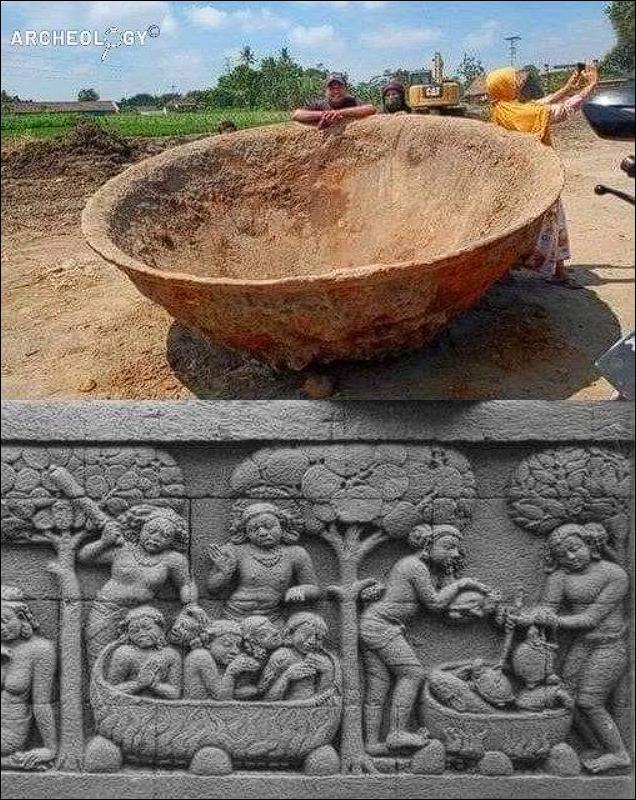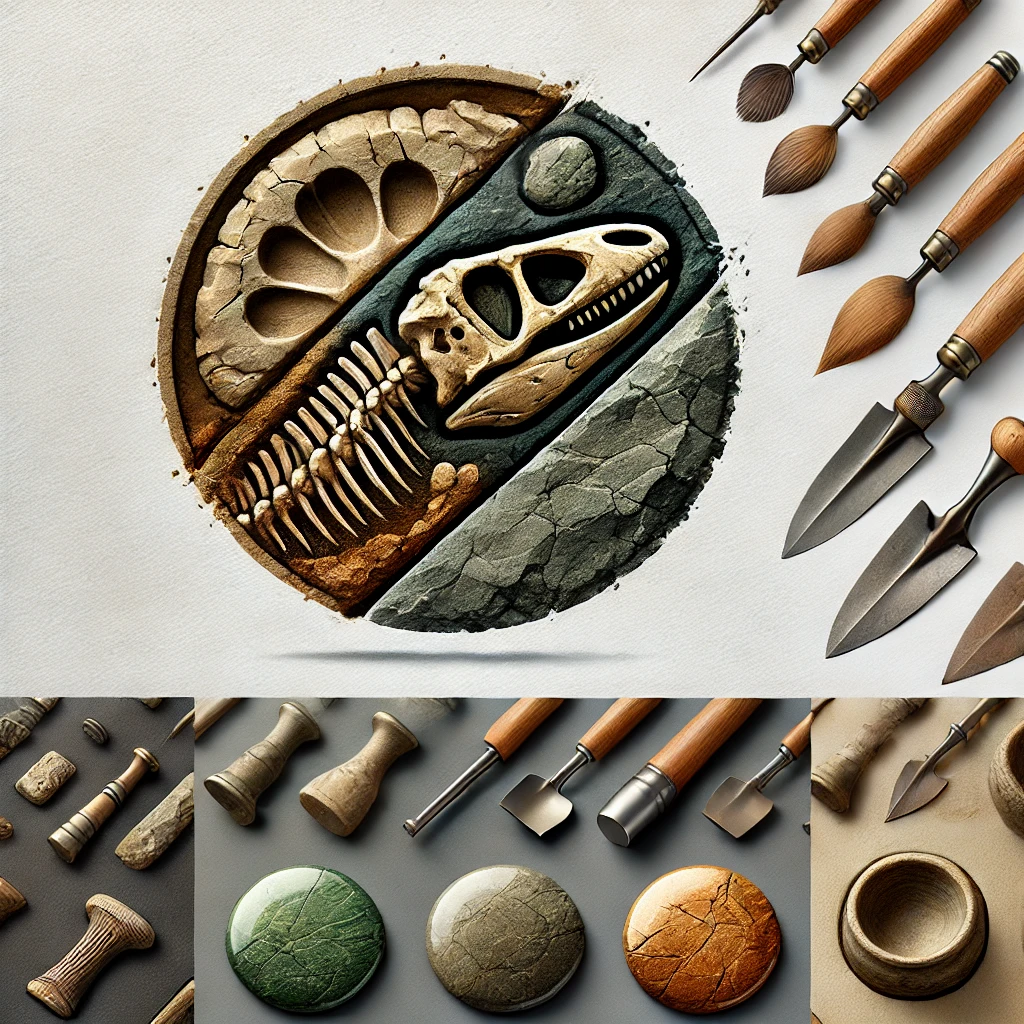The Bronze Cauldron of Bantul: A Lost Relic Beneath Java’s Sacred Earth
On a humid morning in late August 2021, a road construction team in Bantul, Indonesia, was digging through layers of soil and rock when their tools struck something solid. What emerged from the earth was no ordinary obstruction—a massive bronze cauldron, darkened by time but unmistakably man-made, resting just beneath the surface like a secret waiting centuries to be found.
Roughly shaped like an oversized frying pan or ritual vessel, the object’s size and composition startled workers and archaeologists alike. This wasn’t just industrial scrap. It was something older—perhaps far older.
Only 50 kilometers away, on the storied walls of Borobudur Temple, the world’s largest Buddhist monument, an ancient image carved in stone might offer a clue. On one of the Karma-Vibhanga relief panels, giant beings tower over human figures immersed in flaming cauldrons—a vivid portrayal of karmic retribution. The resemblance to the Bantul artifact is more than coincidental.
Could the bronze vessel unearthed in Bantul be more than a practical tool? Could it carry ritualistic or symbolic meaning, echoing the beliefs, punishments, or mythologies etched into Java’s ancient past?
Unearthing the Artifact: A Cauldron Unlike Any Other
Discovery During Routine Construction
The artifact was discovered on August 31, 2021, in Kalurahan Jogotirto, Berbah District, Bantul Regency. Construction workers were clearing land for a road expansion project when they struck a dense, metallic object buried just beneath the topsoil. Upon careful excavation, they revealed a giant bronze cauldron, partially crushed but unmistakably crafted.
The artifact measures over 1 meter in diameter, with thick bronze walls and a wide, shallow base. Its shape puzzled local experts—too large for domestic use, too heavy for regular transport, and too undecorated to immediately classify as ceremonial. Still, its sheer scale and craftsmanship demanded attention.
Immediate Archaeological Interest
The local Cultural Heritage Preservation Center quickly dispatched a team. Initial assessments confirmed that the object was made of cast bronze, consistent with ancient metallurgical techniques. However, its exact age remains unclear—carbon dating isn’t possible for metal, and no accompanying artifacts were found to establish a firm timeline.
Was it from the early Javanese kingdoms? Could it predate even that?
The artifact was secured and transported for further analysis, but questions still linger about its original use and cultural significance.
Echoes in Stone: The Borobudur Relief and the Mystery of the Cauldrons
Karma-Vibhanga: A Glimpse into Buddhist Cosmology
Just an hour’s drive north lies Borobudur Temple, a UNESCO World Heritage Site and one of Southeast Asia’s greatest religious landmarks. Built in the 8th–9th century by the Sailendra dynasty, Borobudur is covered in more than 2,600 relief panels, each depicting scenes from Buddhist texts, daily life, and metaphysical visions.
Among these, the Karma-Vibhanga panels tell stories of cause and effect, sin and virtue, punishment and reward. One panel, in particular, captures the imagination: giant, wrathful beings looming over humans submerged in enormous cauldrons, tongues of fire rising from below.
A Startling Visual Parallel
To the trained eye, the resemblance between the Bronze Cauldron of Bantul and the cauldrons in Borobudur’s reliefs is striking. The proportions, the flared rims, and the exaggerated size match almost too perfectly. Could this be more than coincidence?
Was the artifact a ritual object inspired by religious art, or could it have inspired the artists of Borobudur themselves? Was it used in ceremonies reenacting karmic purification? Or, perhaps, was it symbolic, placed in sacred spaces to physically manifest metaphysical teachings?
Theories Surrounding the Cauldron’s Purpose
A Ritual Vessel for Temple or Court
One possibility is that the cauldron served in a ritual capacity, perhaps used to heat water, oils, or offerings during temple ceremonies. Ancient Javanese courts and religious centers often practiced elaborate rituals combining Hindu-Buddhist beliefs, and a vessel of this scale could have supported such grand displays.
The absence of inscriptions or decorations might suggest that its function was more practical than symbolic, though the two often overlapped in ancient rites.
A Cremation or Purification Tool?
Another theory is that the cauldron was part of cremation rites or purification ceremonies, in which fire and water symbolized transformation. Large bronze vessels have been found in various parts of Asia serving similar functions—either to burn offerings or to hold water for ritual cleansing.
Given Java’s long history of syncretic religious practices, it’s plausible the cauldron straddled multiple traditions: Buddhist, Hindu, and even pre-Vedic animism.
A Symbol of Punishment or Cosmological Display?
Or perhaps, as the Borobudur panel suggests, the cauldron wasn’t meant to be used, but to be seen—a symbolic object meant to reflect the cosmic consequences of karma. Just as medieval Christian churches employed hellish imagery to instruct the illiterate, this cauldron might have been a tangible warning of spiritual discipline.
Placed in a temple courtyard or procession, it may have served as a dramatic centerpiece—a “living sculpture” echoing the punishments carved in stone at Borobudur.
A Bronze Link to Indonesia’s Layered Past
The Sailendra Dynasty and Java’s Golden Age
During the 8th and 9th centuries, Java flourished under the Sailendra dynasty, who oversaw a golden age of temple-building, artistic innovation, and religious fusion. Borobudur itself was likely constructed during this time, combining Mahayana Buddhist ideals with local architectural brilliance.
If the cauldron dates to this period, it would place it among the most culturally rich centuries in Javanese history, when bronze casting, stone carving, and spiritual expression reached new heights.
The Geographic Proximity to Borobudur
The cauldron’s discovery just 50 kilometers south of Borobudur is more than a geographical coincidence. It suggests the possibility of regional continuity, where ideas, art, and artifacts circulated freely. While Bantul may not have been a major religious center, it could have been part of a larger ceremonial network linked to Borobudur’s spiritual influence.
Final Reflections: What Lies Beneath the Surface
The Bronze Cauldron of Bantul remains, for now, an enigma. Its age is uncertain, its function unclear, its origin still shrouded in speculation. But its discovery—unexpected, powerful, and symbolically charged—adds another layer to Indonesia’s richly stratified past.
And then there’s the coincidence—the alignment of earth and stone, of artifact and image. That an object buried beneath a modern road might mirror the visions of an ancient temple suggests that history is never truly gone, only waiting to be unearthed.
Perhaps what we’ve found is not just a cauldron, but a question cast in bronze.

CÁC TIN KHÁC
Mary Walton: The Forgotten Inventor Who Helped Clean Up America’s Cities
Tomb of Queen Nefertari in the Valley of the Queens, Egypt
Discover the Hypostyle Hall of the Temple of Hathor at Dendera
Venus de Losange: Unveiling the Mystery of a 20,000-Year-Old Paleolithic Icon